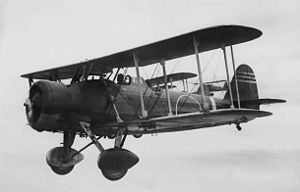

| D1A | |
|---|---|

| |
| Role | Dive bomber
Type of aircraft
|
| National origin | Japan |
| Manufacturer | Aichi Kokuki KK |
| First flight | 1934[1] |
| Retired | 1942 |
| Status | Retired |
| Primary user | Imperial Japanese Navy Air Service |
| Number built | 590[2] |
The Aichi D1AorNavy Type 94/96 Carrier Bomber (Allied reporting name "Susie"[3]) was a Japanese carrier-based dive bomber of the 1930s. A single-engine, two-seat biplane based on the Heinkel He 50, the D1A was produced by Aichi for the Imperial Japanese Navy, remaining in service as a trainer at the time of the attack on Pearl Harbor. The D1A was produced in two variants, the D1A1 (Navy Type 94 Carrier Bomber), and the D1A2 (Navy Type 96 Carrier Bomber, sometimes referred to as the D2A).
The D1A came out of the Imperial Japanese Navy's need for an advanced carrier-based dive bomber, and in late 1934 the IJN ordered the finalisation of the Aichi AB-9 design which was produced as the early model D1A1.[2] However, the D1A1 was not designed by Aichi Tokei Denki Kabushiki Kaisha [ja] aircraft company (later Aichi Kokuki), but by Ernst Heinkel Flugzeugwerke at the request of the Aichi company. The initial version designed by Heinkel was the He 50, a similar model equipped with floats instead of landing gear. The subsequent model, the He 66 was provided to Aichi who immediately began production of it as the D1A1.
The design of the D1A, based on the Heinkel He 66, an export model of the He 50, was designed as a biplane constructed of metal, with a fabric covering, a fixed landing gear and a conventional type tail landing skid. Original models had 365 kW (490 hp) engines and it was not until later models that more powerful 433 kW (580 hp) engines were included in the construction.
The D1A was primarily used in the Second Sino-Japanese War and up to the time Japan entered World War II in 1941. At the beginning of the Pacific War, all of the remaining D1A1s were decommissioned and most of the D1A2s were retired from the front lines and served primarily in training units. The exception was 68 of the D1A2 model that operated as a second-line support until being retired in 1942.[2]

Data from Japanese Aircraft of the Pacific War[5] and Aircraft of World War II - 300 of the World's Greatest aircraft 1939-45 [2]
General characteristics
Performance
Armament
Related development
Aircraft of comparable role, configuration, and era
Related lists
|
Aichi aircraft
| |
|---|---|
| Manufacturer designations |
|
| Imperial Japanese Navy short designations |
|
| World War II Allied reporting names |
|
|
| |
|---|---|
| Fighters (A) |
|
| Torpedo bombers (B) |
|
| Shipboard reconnaissance (C) |
|
| Dive bombers (D) |
|
| Reconnaissance seaplanes (E) |
|
| Observation seaplanes (F) |
|
| Land-based bombers (G) |
|
| Flying Boats (H) |
|
| Land-based Fighters (J) |
|
| Trainers (K) |
|
| Transports (L) |
|
| Special-purpose (M)1 |
|
| Floatplane fighters (N) |
|
| Land-based bombers (P) |
|
| Patrol (Q) |
|
| Land-based reconnaissance (R) |
|
| Night fighters (S) |
|
1 X as second letter is for experimental aircraft or imported technology demonstrators not intended for service, 2 Hyphenated trailing letter (-J, -K, -L, -N or -S) denotes design modified for secondary role, 3 Possibly incorrect designation, but used in many sources | |
|
| |
|---|---|
| Aircraft in Japanese service |
|
| Foreign aircraft thought to be in Japanese service |
|